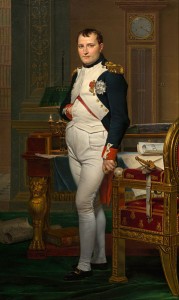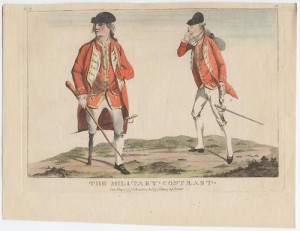The memory began like a fairytale or Greek myth. A young soldier walked along a forest road in the Highlands in the summer of 1780, the fifth year of the war. Turning a corner, about forty yards off, he saw a young woman who had “divested herself of some of her outside garments” in the heat of the day. As the soldier later recalled, she quickly slipped on her clothes and continued towards him, at first “seemingly quite unconcerned.” She quickly changed her mind – clearly concluding “it would not be quite safe to encounter a solider in such a place” – and ran off through the underbrush. The soldier called after her – but she only ran faster. “She seemed,” he thought, “in a violent panic” (A Narrative of a Revolutionary Soldier, 172).
The young woman’s fear was well-founded. In the War for Independence, King George’s Regulars and George Washington’s Continentals alike robbed houses and barns, drove off livestock, and smashed up fences for firewood. Rogue soldiers assaulted women – a crime that propagandists either played up or covered up, depending on the predator’s uniform. Despite deep-seated mistrust, under the right circumstances, soldiers and civilians could get on. But when? How?
One answer lay with the soldiers themselves. As soldiers, young Continentals were outsiders, strangers. If, however, civilians saw these soldiers as youths – as the overwhelming majority of soldiers were youths – they could fit them into a familiar place in their communities. Soldiers could win kindness from wary civilians and a warm spot by the fire when they reminded inhabitants of their own sons, when they hired themselves out as labor, and when they courted local girls.
The inhabitants’ existing relationship with soldiers mattered immensely: had they suffered at soldiers’ hands or did they miss their own lads who had gone for soldiers? Private Joseph Plumb Martin recalled the kindness of a “good old housewife” who “lamented that we had no mothers nor sisters to take care of us.” Because her own sons had suffered hunger, cold, and filth in the army, she fed the teenaged soldiers “with as much ease and familiarity as though we had belonged to the family” (A Narrative of a Revolutionary Soldier, 217). Emotional connection helped some civilians see the familiar youth within the soldier on their doorstep.
For their part, young soldiers could ease their relationships with civilians by presenting themselves as helpful and subordinate. When his Pennsylvania regiment traveled south to Yorktown, Samuel Dewees – who was little more than a boy – was left behind with some fellow musicians, invalids, and raw recruits. Billeted at a public house run by the Zeiglers, he became an accepted member of the household. “I drew my rations and handed them to the family,” he recalled. “I lived here (I may state) at home, for I ate at the table with the family, and was treated as one of the family.” When he wasn’t practicing his fife, Dewees undertook “many little jobs of work for the family” (A History, 233). He lived with the Zeiglers for half a year. The boy soldier made himself no different from a hired hand or apprentice.
John Robert Shaw, a young British deserter who had joined the Continental army, showed how young soldiers could slip into civilian communities while still serving in the army. Garrisoned at Carlisle, Pennsylvania, Shaw was doubly an outsider as a soldier and an Englishman. This proved to matter little in the ethnically diverse crossroads town. Indeed, after “a considerable time” in town, Shaw “began to grow weary of the single life” and “paid addresses to a certain young woman,” Mary O’Hara, an Irish immigrant who worked for an inn-keeper. After a short courtship, Shaw reported they “were married at the home of Mr. Robert Johnson, a respectable citizen, who gave us a good dinner, and in the evening, I was conducted to the barracks, with my new bride, by a number of soldiers of the first respectability.” Shaw had to bridge military and civilian spheres to support his wife, getting permission from his officers to work in the town and then scoring employment with a merchant in town “by the recommendation and interest of one Robert Gibson,” a prominent townsman (Autobiography, 57-58). Work and marriage brought Shaw into the community’s embrace.
Courtship proved fear and fascination could go hand in hand. As a song from 1778 put it, “Hark! the distant Drum, / Lasses all look frighted; / But, when Soldiers come, / Girls how you’re delighted.” Sally Wister, a Quaker teenager in Pennsylvania demonstrated exactly these feelings in October 1777. Her first encounters with Continental soldiers began with the terrifying appearance of dragoons at her father’s door seeking to buy horses. Though bristling with weapons, they proved polite. The Wisters were fortunate an American general chose their well-appointed house for his headquarters – “which,” Sally wrote to a friend, “secur’d us from straggling soldiers.” With no predators to fear, the girls of the household turned hunters: “our dress and lips were put in order for conquest and the hopes of adventures gave brightness to each.” With the girls stalking so many young officers, it was not surprising when one “fell violently in love with Liddy at first sight,” while Sally herself swooned over a major from Maryland. “How new is our situation,” she exclaimed, “I am going to my chamber to dream I suppose of bayonets and swords, sashes, guns, and epaulets” (Journal and Occasional Writings, 43-50). A surgeon at West Point wryly noted the military side of the battle of the sexes, describing how one young officer had been “mortally wounded – with one of Cupid’s arrows, I mean, shot from the small blue eyes of a minister’s daughter…” (Samuel Adams to Sally Preston Adams, 11 August 1779).
During the Revolution, civilians might see the familiar form of a young man under the threatening guise of a soldier if he presented himself as a potential member of their community. These positive encounters stand out as exceptions, however. Historically, civilians suffer at the hands of soldiers – whether they be eighteenth century foraging parties searching for food or twenty-first century sentries at dusty checkpoints searching for insurgents. And yet non-combatants tend to fade into the background of war stories. Similarly, in the United States today soldier-civilian tensions are usually beyond our view, either far over the horizon or deep in the past. For the revolutionary generation, however, the demands of armies on inhabitants – and the burdens of occupation – were fresh memories. Rather than rely on young soldiers’ interest in work or women, citizens of the new republic insisted on the Constitution’s now-unremarkable Third Amendment, in which their consent and the due process of law would protect them from their soldiers.
(Jake Ruddiman is an Assistant Professor of History at Wake Forest University. His teaching and writing explore Revolutionary America as a hinge between eras.)

